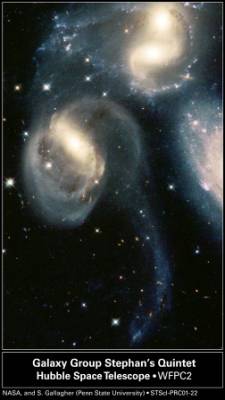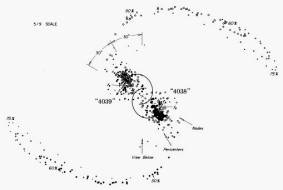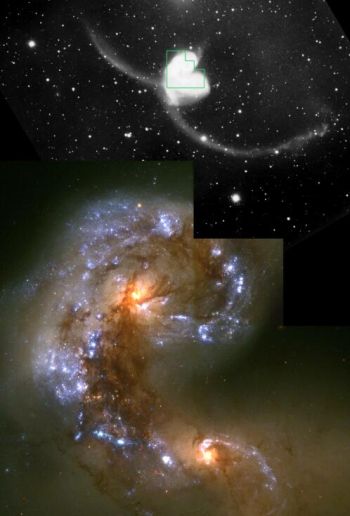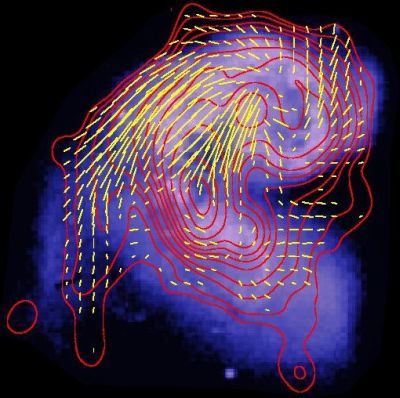Interactig galaxies
What we know on galaxy interactions: early attempts
 When Edwin Hubble in the first half of the previous century formulated his classification of galaxies, he divided them into spirals, elipticals, and irregulars. However, some objects did not suit that scheme. They resembled normal galaxies, but had distorted spiral arms, shining bridges with other galaxies, or strange, long tails. However those cases were considerd as pathological ones, of no importance.
When Edwin Hubble in the first half of the previous century formulated his classification of galaxies, he divided them into spirals, elipticals, and irregulars. However, some objects did not suit that scheme. They resembled normal galaxies, but had distorted spiral arms, shining bridges with other galaxies, or strange, long tails. However those cases were considerd as pathological ones, of no importance.
Within the next decades, more and more objects with peculiar structures were discovered. They had blue colours, manifesting enhanced star formation. They seemed to show up more often in clusters of galaxies (as in these pictures) than among the isolated field galaxies. This led some astronomers to suspect that the observed distortions might be caused by gravitational interactions between nearby passing galaxies.
However, in 1958 Ambartsumyan, followed by Vorontsov-Velyaminov, proposed an alternative scenario. They argued that galaxy peculiarities arise from their fragmentations, or even explosions. Without nowadays computers, testing these different hypotheses was then quite a difficult task.
Simulations
 Bulb computer
Bulb computer
Eric Holmberg (1941), ApJ
Already in 1941 a Swedish astronomer Eric Holmberg shed a new light on this problem by carrying out an ingenious experiment, published in ApJ. We know that the gravitational force follows an inverse‑square law. The flux of light from a bright object follows the same law. Holmberg arranged 74 bulbs into two spirals of 37 bulbs. Using photocells he measured the flux of the light at each bulb, so he could estimate the magnitude and the direction of the gravitational force, and move the bulbs according to this force. With this bulb computer using light for tracing gravity, he showed that gravitation can actually change shapes of galaxies and over milliards of years develop peculiar structures.
 First realistic computer simulatons
First realistic computer simulatons
based on a restricted 3-body code
Alar and Juri Toomre (1972)
Some thirty years later, brothers Alar and Juri Toomre published their first, famous realistic computer simulations of interacting galaxies based on a restricted 3-body code. They were able to reproduce a number of features of observed nearby colliding galaxies to a surprising extend. For example, they reproduced the long tails in a pair of merging spiral galaxies called the Antennae, about which I will talk in the third part of the talk. They showed that the tails are produced by gravitation, that is by tidal interactions. So the hypothesis of exploding galaxies was refuted.
The Antennae merging galaxies (NGC 4038/4039)
 The Antennae is just a violently interacting system of two spiral galaxies, which experienced a close encounter about 300mln years ago. The Earth-based photographs show characteristic long tails of matter expelled from the galaxies. How violent this collision is, it can bee seen in the HST picture which reveals a very chaotic interstellar medium, and dust lanes mixed up with young population of stars of blue colour. Star formation rate is a few times higher than in normal spirals. Numerical simulations show that the galaxies are just before the second encounter. Then, in about 100mln years, they will merge together, making up an elliptical galaxy.
The Antennae is just a violently interacting system of two spiral galaxies, which experienced a close encounter about 300mln years ago. The Earth-based photographs show characteristic long tails of matter expelled from the galaxies. How violent this collision is, it can bee seen in the HST picture which reveals a very chaotic interstellar medium, and dust lanes mixed up with young population of stars of blue colour. Star formation rate is a few times higher than in normal spirals. Numerical simulations show that the galaxies are just before the second encounter. Then, in about 100mln years, they will merge together, making up an elliptical galaxy.
 In this picture you can see the total radio intensity contours at 3.6 cm and magnetic field vectors as dashes overlaid upon the optical DSS image. The length of dashes is proportional to the polarized intensity. The system is rich in magnetic structures of various kind. There is a relic magnetic spiral arm in the northern galaxy corresponding to the optical one. However, magnetic vectors are not directed along the structure but are inclined by some 45 degrees to it. This is a foortprint of a dynamo action. In the north-east region magnetic fields run parallel to a rather sharp boundary of the optical emission. In the vicinity of the nucleus of the northern galaxy they are almost radial, following local dust lanes. Some traces of another spiral structure with very large pitch angles can be seen around the southern galaxy. A strong magnetic structure is also visible between galaxies in the overlapping region. Coherent fields probably trace the gas flows between galaxies. In the north-eastern part of the system magnetic fields make another structure which is aligned with a tidal tail. Magnetic fields are very regular here, probably due to the gas stretching motions along the tail. The structure also suggests that magnetic fields are expelled from the system to the intergalacting medium.
In this picture you can see the total radio intensity contours at 3.6 cm and magnetic field vectors as dashes overlaid upon the optical DSS image. The length of dashes is proportional to the polarized intensity. The system is rich in magnetic structures of various kind. There is a relic magnetic spiral arm in the northern galaxy corresponding to the optical one. However, magnetic vectors are not directed along the structure but are inclined by some 45 degrees to it. This is a foortprint of a dynamo action. In the north-east region magnetic fields run parallel to a rather sharp boundary of the optical emission. In the vicinity of the nucleus of the northern galaxy they are almost radial, following local dust lanes. Some traces of another spiral structure with very large pitch angles can be seen around the southern galaxy. A strong magnetic structure is also visible between galaxies in the overlapping region. Coherent fields probably trace the gas flows between galaxies. In the north-eastern part of the system magnetic fields make another structure which is aligned with a tidal tail. Magnetic fields are very regular here, probably due to the gas stretching motions along the tail. The structure also suggests that magnetic fields are expelled from the system to the intergalacting medium.
 We performed calculations of total and regular magnetic fields under the equipartition condition. The large values represent total magnetic field strength and the small ones the ratio of regular to random components which measure the field regularity. Yellow boxes contain average magnetic fields over galaxies, the overlapping region and for the whole system and green ones present the local values. A mean total magnetic field of 20 muG is about 2 times stronger than in normal spirals, for which this value is about 8 to 10 muG. This amplification must be a result of strong interaction. Locally, the strongest fields of about 30 muG are observed outside galaxy disks. This is a rather high value. Such strong large-scale fields have never been observed before outside of galaxy centres. The field regularity is rather low. Typical values of 0.2, 0.3 are in contrast with other galaxies for which these values are about 0.5. This means that in that interacting system either strong amplification of turbulent fields occurs or both turbulent and regular magnetic fields are generated but the regular fields are much more tangled in the starburst regions than in normal galaxies. In the north-eastern part, far away from star-forming regions, the magnetic fields become more ordered. This is probably a result of gas shearing motion at the base of the tidal tail.
We performed calculations of total and regular magnetic fields under the equipartition condition. The large values represent total magnetic field strength and the small ones the ratio of regular to random components which measure the field regularity. Yellow boxes contain average magnetic fields over galaxies, the overlapping region and for the whole system and green ones present the local values. A mean total magnetic field of 20 muG is about 2 times stronger than in normal spirals, for which this value is about 8 to 10 muG. This amplification must be a result of strong interaction. Locally, the strongest fields of about 30 muG are observed outside galaxy disks. This is a rather high value. Such strong large-scale fields have never been observed before outside of galaxy centres. The field regularity is rather low. Typical values of 0.2, 0.3 are in contrast with other galaxies for which these values are about 0.5. This means that in that interacting system either strong amplification of turbulent fields occurs or both turbulent and regular magnetic fields are generated but the regular fields are much more tangled in the starburst regions than in normal galaxies. In the north-eastern part, far away from star-forming regions, the magnetic fields become more ordered. This is probably a result of gas shearing motion at the base of the tidal tail.
For details see: Chyy K.T., Beck R., 2004, "Magnetic fields in merging spirals - the Antennae", AA, 417, 541
 When Edwin Hubble in the first half of the previous century formulated his classification of galaxies, he divided them into spirals, elipticals, and irregulars. However, some objects did not suit that scheme. They resembled normal galaxies, but had distorted spiral arms, shining bridges with other galaxies, or strange, long tails. However those cases were considerd as pathological ones, of no importance.
When Edwin Hubble in the first half of the previous century formulated his classification of galaxies, he divided them into spirals, elipticals, and irregulars. However, some objects did not suit that scheme. They resembled normal galaxies, but had distorted spiral arms, shining bridges with other galaxies, or strange, long tails. However those cases were considerd as pathological ones, of no importance. Bulb computer
Bulb computer First realistic computer simulatons
First realistic computer simulatons The Antennae is just a violently interacting system of two spiral galaxies, which experienced a close encounter about 300mln years ago. The Earth-based photographs show characteristic long tails of matter expelled from the galaxies. How violent this collision is, it can bee seen in the HST picture which reveals a very chaotic interstellar medium, and dust lanes mixed up with young population of stars of blue colour. Star formation rate is a few times higher than in normal spirals. Numerical simulations show that the galaxies are just before the second encounter. Then, in about 100mln years, they will merge together, making up an elliptical galaxy.
The Antennae is just a violently interacting system of two spiral galaxies, which experienced a close encounter about 300mln years ago. The Earth-based photographs show characteristic long tails of matter expelled from the galaxies. How violent this collision is, it can bee seen in the HST picture which reveals a very chaotic interstellar medium, and dust lanes mixed up with young population of stars of blue colour. Star formation rate is a few times higher than in normal spirals. Numerical simulations show that the galaxies are just before the second encounter. Then, in about 100mln years, they will merge together, making up an elliptical galaxy. In this picture you can see the total radio intensity contours at 3.6 cm and magnetic field vectors as dashes overlaid upon the optical DSS image. The length of dashes is proportional to the polarized intensity. The system is rich in magnetic structures of various kind. There is a relic magnetic spiral arm in the northern galaxy corresponding to the optical one. However, magnetic vectors are not directed along the structure but are inclined by some 45 degrees to it. This is a foortprint of a dynamo action. In the north-east region magnetic fields run parallel to a rather sharp boundary of the optical emission. In the vicinity of the nucleus of the northern galaxy they are almost radial, following local dust lanes. Some traces of another spiral structure with very large pitch angles can be seen around the southern galaxy. A strong magnetic structure is also visible between galaxies in the overlapping region. Coherent fields probably trace the gas flows between galaxies. In the north-eastern part of the system magnetic fields make another structure which is aligned with a tidal tail. Magnetic fields are very regular here, probably due to the gas stretching motions along the tail. The structure also suggests that magnetic fields are expelled from the system to the intergalacting medium.
In this picture you can see the total radio intensity contours at 3.6 cm and magnetic field vectors as dashes overlaid upon the optical DSS image. The length of dashes is proportional to the polarized intensity. The system is rich in magnetic structures of various kind. There is a relic magnetic spiral arm in the northern galaxy corresponding to the optical one. However, magnetic vectors are not directed along the structure but are inclined by some 45 degrees to it. This is a foortprint of a dynamo action. In the north-east region magnetic fields run parallel to a rather sharp boundary of the optical emission. In the vicinity of the nucleus of the northern galaxy they are almost radial, following local dust lanes. Some traces of another spiral structure with very large pitch angles can be seen around the southern galaxy. A strong magnetic structure is also visible between galaxies in the overlapping region. Coherent fields probably trace the gas flows between galaxies. In the north-eastern part of the system magnetic fields make another structure which is aligned with a tidal tail. Magnetic fields are very regular here, probably due to the gas stretching motions along the tail. The structure also suggests that magnetic fields are expelled from the system to the intergalacting medium. We performed calculations of total and regular magnetic fields under the equipartition condition. The large values represent total magnetic field strength and the small ones the ratio of regular to random components which measure the field regularity. Yellow boxes contain average magnetic fields over galaxies, the overlapping region and for the whole system and green ones present the local values. A mean total magnetic field of 20 muG is about 2 times stronger than in normal spirals, for which this value is about 8 to 10 muG. This amplification must be a result of strong interaction. Locally, the strongest fields of about 30 muG are observed outside galaxy disks. This is a rather high value. Such strong large-scale fields have never been observed before outside of galaxy centres. The field regularity is rather low. Typical values of 0.2, 0.3 are in contrast with other galaxies for which these values are about 0.5. This means that in that interacting system either strong amplification of turbulent fields occurs or both turbulent and regular magnetic fields are generated but the regular fields are much more tangled in the starburst regions than in normal galaxies. In the north-eastern part, far away from star-forming regions, the magnetic fields become more ordered. This is probably a result of gas shearing motion at the base of the tidal tail.
We performed calculations of total and regular magnetic fields under the equipartition condition. The large values represent total magnetic field strength and the small ones the ratio of regular to random components which measure the field regularity. Yellow boxes contain average magnetic fields over galaxies, the overlapping region and for the whole system and green ones present the local values. A mean total magnetic field of 20 muG is about 2 times stronger than in normal spirals, for which this value is about 8 to 10 muG. This amplification must be a result of strong interaction. Locally, the strongest fields of about 30 muG are observed outside galaxy disks. This is a rather high value. Such strong large-scale fields have never been observed before outside of galaxy centres. The field regularity is rather low. Typical values of 0.2, 0.3 are in contrast with other galaxies for which these values are about 0.5. This means that in that interacting system either strong amplification of turbulent fields occurs or both turbulent and regular magnetic fields are generated but the regular fields are much more tangled in the starburst regions than in normal galaxies. In the north-eastern part, far away from star-forming regions, the magnetic fields become more ordered. This is probably a result of gas shearing motion at the base of the tidal tail.